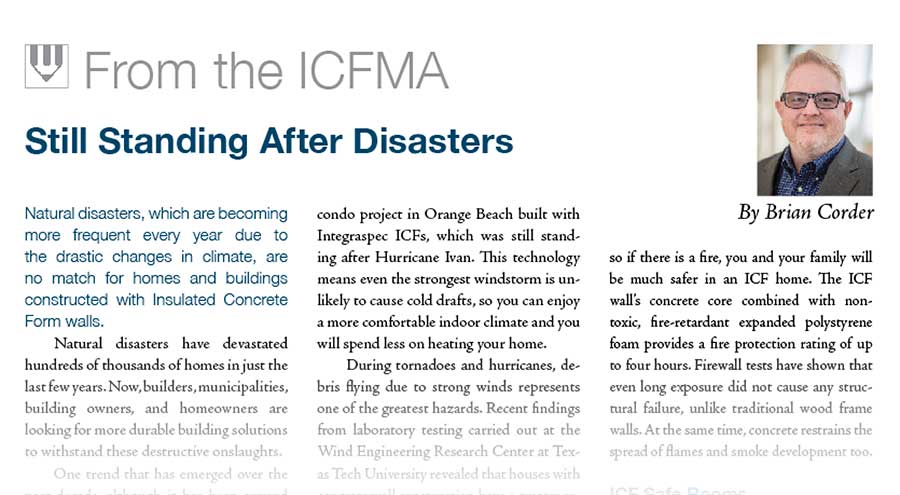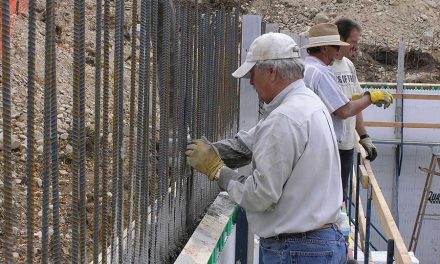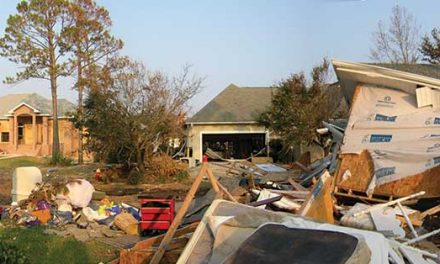Natural disasters, which are becoming more frequent every year due to the drastic changes in climate, are no match for homes and buildings constructed with Insulated Concrete Form walls.
Natural disasters have devastated hundreds of thousands of homes in just the last few years. Now, builders, municipalities, building owners, and homeowners are looking for more durable building solutions to withstand these destructive onslaughts.
One trend that has emerged over the past decade, although it has been around for more than 20 years, is the use of insulated concrete forms (ICFs), to build the walls of homes and buildings as an alternative to wood framing. “Due to high demand, more builders are opting for the strongest impact-resilient house available,” says Natalie Rodgers with Nudura, a leading name in building with insulated concrete forms. “This ICF method is an advanced departure from traditional wood framing — and our Canadian design is recognized to be even more efficient. At the construction site, these compact concrete forms interlock (like Lego) to build a rock-solid wall.”
Peace Of Mind
Studies have proven that Insulating Concrete Form–built concrete walls are 10 times stronger than wood-framed structures. Concrete buildings have myriad advantages over wood-frame buildings, and one key feature is their disaster resistance.
Resistance To Debris From Strong Winds
ICF homes and buildings can withstand winds and flying debris of up to 250 miles per hour, or an F4 tornado. In fact, a home that used Nudura ICFs was still standing in Florida after Hurricane Michael. Another example is a Caribbean condo project in Orange Beach built with Integraspec ICFs, which was still standing after Hurricane Ivan. This technology means even the strongest windstorm is unlikely to cause cold drafts, so you can enjoy a more comfortable indoor climate and you will spend less on heating your home.
During tornadoes and hurricanes, debris flying due to strong winds represents one of the greatest hazards. Recent findings from laboratory testing carried out at the Wind Engineering Research Center at Texas Tech University revealed that houses with concrete wall construction have a greater resistance to impact compared to traditional wood-frame houses, with walls that failed to prevent the penetration of airborne hazards.
Earthquake Resistance
The United States and even Canada are experiencing more seismic activity. An ICF wall system provides better anchorage for your house or building, thanks to the concrete core and the forms’ flexibility, which allows the builder to add and accurately position vertical and horizontal steel reinforcement.
Homes and buildings constructed with reinforced concrete walls are among the most solid structures in an earthquake. Reinforced concrete walls have been tested after earthquake impacts and the conclusion is they resist compression forces. The reinforcement, whether it be steel or other approved reinforcing materials, used in ICFs also resists tensile forces created during an earthquake. The bars are tightly locked into place by the concrete, generating earthquake-resistant properties such as strength, stiffness, and ductility. Modern reinforced concrete buildings have rarely succumbed to heavy damages during recent earthquakes.
Fire Resistance
Concrete is less flammable than wood, so if there is a fire, you and your family will be much safer in an ICF home. The ICF wall’s concrete core combined with non-toxic, fire-retardant expanded polystyrene foam provides a fire protection rating of up to four hours. Firewall tests have shown that even long exposure did not cause any structural failure, unlike traditional wood frame walls. At the same time, concrete restrains the spread of flames and smoke development too.
ICF Safe Rooms
Most homeowners and building owners are worried about their home’s ability to cope with the damage caused by severe storms, hurricanes, and tornados. Life safety is top priority, of course, closely followed by the financial costs associated with building destruction and property loss. Especially in areas of the world susceptible to these weather occurrences, Insulated Concrete Forms (ICFs) are a building material solution that address all these disaster-related concerns.
Don’t wait until a natural disaster strikes your town to take action to reinforce your home or building. There are precautionary steps you can begin now to ensure the utmost protection of your structure and your family in the event of severe weather.
ICFs can be used to create not only safe houses and structures, but safe rooms, which can be the master bedroom closet, for example. Apart from ICF walls, a concrete “lid” is poured on the top and a steel door is installed. During disasters, this ICF safe room can protect the whole family.

Brian Corder
Brian Corder is the marketing chair of the Insulating Concrete Forms Manufacturers Association (ICFMA, www.icf-ma.org) and the president and CEO of BuildBlock Building Systems (www.buildblock.com).














In 2012 I built a 3,300 sq ft ICF house in Florida. Been hit by right front eyewall of three hurricanes and ZERO damage.